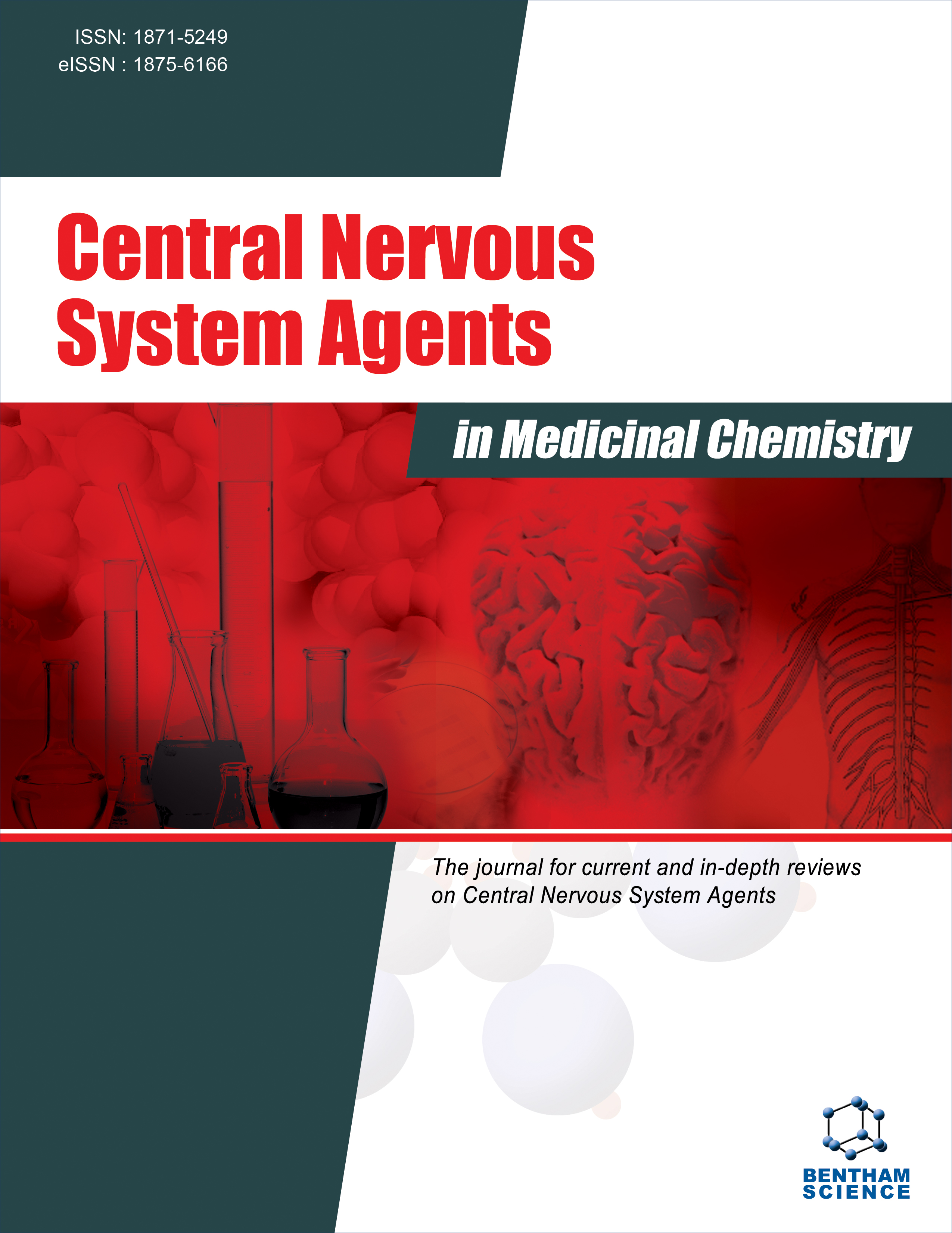- Home
- A-Z Publications
- Central Nervous System Agents in Medicinal Chemistry (Formerly Current Medicinal Chemistry - Central Nervous System Agents)
- Previous Issues
- Volume 12, Issue 1, 2012
Central Nervous System Agents in Medicinal Chemistry (Formerly Current Medicinal Chemistry - Central Nervous System Agents) - Volume 12, Issue 1, 2012
Volume 12, Issue 1, 2012
-
-
Editorial
More LessAuthors: Gregory S. Hamilton and Maria Luz Lopez RodriguezRecent years have seen a sea-change in the pharmaceutical industry and the way in which it seeks new medicines. The decline in productivity of the sector, as defined by the number of drugs successfully discovered and developed per R&D spend, has been declining for many years, as documented in numerous studies. (See for example, Scannell et al., Nature Reviews Drug Discovery, 2012, 11, 191 - 200, and reference Read More
-
-
-
Evaluation of Small Molecule Tuberculostats for Targeting Tuberculosis Infections of the Central Nervous System
More LessTuberculosis infection of the central nervous system is a serious and frequently fatal disease. Four drugs have been found to very efficiently inhibit the growth of Mycobacterium tuberculosis and are examined for molecular properties that enable penetration of the blood-brain barrier. Drugs 1, 2, and 3 are aromatic compounds having a single bromine atom in ortho, meta, and para-position, respectively, relative to the hydrazid Read More
-
-
-
Targeting Vascular Changes in Lesions in Multiple Sclerosis and Experimental Autoimmune Encephalomyelitis
More LessAuthors: Stephen J. Karlik, Wendi A. Roscoe, Cindy Patinote and Christiane Contino-PepinWhat is the origin of the complex vascular changes that exist in the CNS lesions of Multiple Sclerosis (MS)? From the beginning of the study of the pathological changes in MS in the 19th century, lesions were seen to be associated with veins. On a microscopic level, there have been numerous pathological changes to these vessels including altered structure and permeability, fibrinolysis, iron-related alterations and collagen dep Read More
-
-
-
Neuroprotection for Amyotrophic Lateral Sclerosis: Role of Stem Cells, Growth Factors, and Gene Therapy
More LessAuthors: Rachna S. Pandya, Lilly L. J. Mao, Edward W. Zhou, Robert Bowser, Zhenglun Zhu, Yongjin Zhu and Xin WangVarious molecular mechanisms including apoptosis, inflammation, oxidative stress, mitochondrial dysfunction and excitotoxicity have been implicated in the pathogenesis of amyotrophic lateral sclerosis (ALS), though the exact mechanisms have yet to be specified. Furthermore, the underlying restorative molecular mechanisms resulting in neuronal and/or non-neuronal regeneration have to be yet elucidated. Therap Read More
-
-
-
Conformationally Controlled Mechanistic Aspects of BACE 1 Inhibitors
More LessThis study highlights conformationally controlled mechanistic aspects of peptide inhibitors for BACE 1. Peptide inhibitors with reduced molecular weight tend to have cyclic conformation leading to reduced interactions with catalytic motif. Conformation plays a major role in determining potency of peptide inhibitors. An attempt has been made at designing lead compound with reduced molecular weight along with proper Read More
-
-
-
Basic Sleep Mechanisms: An Integrative Review
More LessRegulation of the sleep-waking cycle is complex and involves diverse brain circuits and molecules. On one hand, an interplay among many neuroanatomical and neurochemical systems including acetylcholine, dopamine, noradrenaline, serotonin, histamine, and hypocretin has been shown to control the waking state. On the other hand the sleep-onset is governed by the activity of sleep-promoting neurons placed in t Read More
-
-
-
Study of Convolvulus pluricaulis for Antioxidant and Anticonvulsant Activity
More LessAuthors: Sristi Verma, Reema Sinha, Puspendra Kumar, Faizal Amin, Jainendra Jain and Shivani TanwarConvolvulus pluricaulis Choisy is a perennial wild herb commonly found on sandy & rocky areas under xerophytic conditions in northern India. It is a reputed drug of ayurveda and reported to posses antioxidant, brain tonic, nervine tonic, laxative and has been used in anxiety, neurosis, epilepsy, insomnia, burning sensation, oedema and urinary disorders. In the present study, methanolic extract of whole plant of Convolvulus pluri Read More
-
-
-
Nasal Neuro EPO Could be a Reliable Choice for Neuroprotective Stroke Treatment
More LessAuthors: Alicia Lagarto Parra and Julio Cesar Garcia RodriguezThe most common cause of stroke is cerebral ischemia, where blood flow to the brain is interrupted due to a thrombus in a major cerebral artery. Currently, the only therapeutic approach available is thrombolysis. A more recent approach that has started to gain attention is neuroprotection, the ability to prevent neuronal death and enhance endogenous protective mechanisms. Several studies have shown the neuroprotective Read More
-
Volumes & issues
-
Volume 25 (2025)
-
Volume 24 (2024)
-
Volume 23 (2023)
-
Volume 22 (2022)
-
Volume 21 (2021)
-
Volume 20 (2020)
-
Volume 19 (2019)
-
Volume 18 (2018)
-
Volume 17 (2017)
-
Volume 16 (2016)
-
Volume 15 (2015)
-
Volume 14 (2014)
-
Volume 13 (2013)
-
Volume 12 (2012)
-
Volume 11 (2011)
-
Volume 10 (2010)
-
Volume 9 (2009)
-
Volume 8 (2008)
-
Volume 7 (2007)
-
Volume 6 (2006)
Most Read This Month
Article
content/journals/cnsamc
Journal
10
5
false
en


